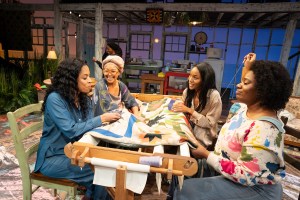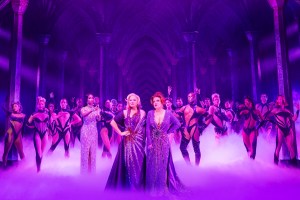Director/Choreographer Warren Carlyle Can Say With Great Satisfaction That It’s Been a Smashing Year
The man at the helm of lively moves in both ”After Midnight” and ”A Christmas Story” lights up the New York theater.
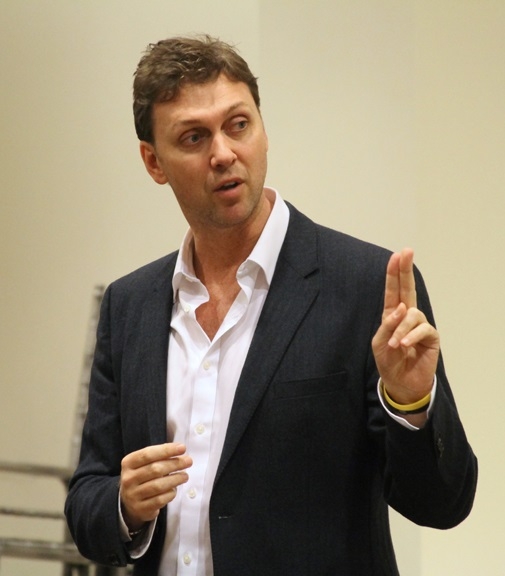
(© Zach Payne)
“There couldn’t be a better holiday season,” says very busy director/choreographer Warren Carlyle. “I truly am blessed to be here and doing what I love. It’s the culmination of all my dreams.”
Carlyle is having a jolly (if hardworking) time. He’s the director/choreographer of the Harlem song-and-dance spectacular After Midnight at Broadway's Brooks Atkinson Theatre, and, in a return engagement following its 2012 Broadway holiday-season engagement, choreographer of John Rando’s production of Joseph Robinette, Benj Pasek, and Justin Paul’s musical A Christmas Story, The Musical at the Theater at Madison Square Garden.
Both projects picked up steam over the last two years: first with the mega success of the seven-week A Christmas Story run, and, following months of auditions and weeks of rehearsal, After Midnight, the Broadway adaptation of Cotton Club Parade, a celebration of Duke Ellington's years at the famed Harlem Cotton Club, in collaboration with City Center Encores! Artistic Director Jack Viertel and Jazz at Lincoln Center’s Wynton Marsalis. After Midnight had limited City Center engagements in November 2011 and June 2012.
As for how Carlyle came to be a choreographer-director, it started at age 10, when his working-class parents in a small community outside Norwich, England, northeast of Cambridge, took him to the city to see Fred Astaire and Ginger Rogers in Top Hat. It became Carlyle's dream to dance.
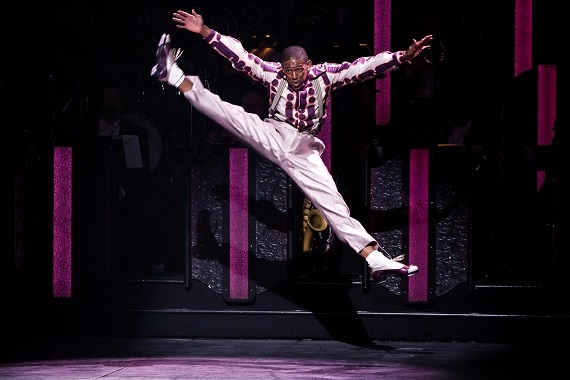
(© Matthew Murphy)
“That’s how I got hooked,” he laughs. “Fred, so debonair in top hat, white tie, tails, flower in lapel, and cane. He was so smooth he made it look so easy. That huge Irving Berlin ‘Piccolini’ sequence with hundreds of people, or so it seemed, singing and dancing! I was on the edge of my seat. From then on, I was enamored with Hollywood musicals.”
He became obsessed with tap, and studied at Norwich’s Central School for Dance. In spite of what he was achieving in sports, where he excelled on the swim and track teams, the addition of dance to his extracurricular repertoire proved quite strange to his mates. “I was bullied. It was awful, hurtful, and tough, but I discovered the best way to handle it was to ignore it. Somehow I had the mind to find my inner strength to do my own thing.”
He knew exactly what that was, “And in my mind, I was already out there doing it. I studied, danced, and performed.” It didn’t come as a shock to his parents when, upon graduating high school, he announced he was London-bound to attend ballet school. “I couldn’t wait,” he notes, “I had to go! But Mom and Dad were supportive from the get-go.”
His first West End job came in 1989, when he was cast as Alonzo in the West End company of Cats.
“I am very tall, which I considered an asset,” he explains. “Since I towered over everyone, choreographers put me in the back or middle.” He loved dancing but felt the urge “to take a leap forward.” Enter Susan Stroman, who tapped Carlyle to be her assistant when she was hired to choreograph Trevor Nunn’s revival of Oklahoma! (starring Hugh Jackman) at the Royal National Theatre.
“I knew who Susan was. It was an honor to be chosen as her assistant.” However, it went beyond that. “I was inspired by her, and still am. She’s generous beyond belief. She taught me everything I know. She’s the master. If there’s one person who changed my life, it’s Susan.”
He followed Stroman to New York to assist on The Producers and the subsequent Broadway revival of Nunn’s Oklahoma! “I loved what I was doing, but wanted to be more creative.” His Broadway debut as a director/choreographer was on the short-lived adaptation of A Tale of Two Cities.
Jack Viertel then chose him to direct and choreograph the City Center Encores! production of Finian’s Rainbow and the retooled staging for Broadway, which earned Carlyle a Drama Desk nomination for choreography. That began an incredible collaboration with Viertel. “We work well together.”
Three years ago, Viertel met with Jazz at Lincoln Center Artistic Director Wynton Marsalis to discuss the idea of doing a coproduction. That led to Cotton Club Parade, helmed and choreographed by Carlyle. “It sounded exciting since I’ve always, always, always been a fan of the Duke’s. There’s nothing like his music. It’s so rich that it’s language to me; and so evocative that I see choreography.”
He explains that Viertel was instrumental in putting everything in place. “We worked up a song list,” he relates, “and sent it to Wynton, who added his thoughts and changed things around a bit. That’s how we built the show, banging the ball back and forth.”
Carlyle explains he develops ideas “by spending lots of time thinking about what I’m going to do before I do it. I work for hours alone because Mom taught me never to go to someone’s home empty-handed. So, I never walk into a meeting without having something to offer. I feel an obligation to bring ideas — a piece of music, a sketch, a video of an idea I’ve worked up.
“What we did with Cotton Club Parade was the seed,” he continues. “The transition to Broadway with it reconceived as After Midnight was smooth. We developed more ideas and enhanced production values. Everything’s now full-blown, top-notch.”
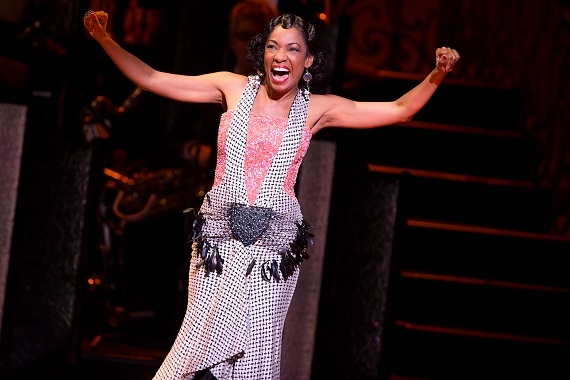
(© Matthew Murphy)
That included casting, which took nine months, working with casting director Laura Stanczyk. “We weren’t looking for actors, singers, dancers who can do everything, but for specialists who excelled at one or two specific things. There were lots of open calls and callbacks to find them. The result, however, is beyond satisfying. They’re simply amazing. And then you add Adriane Lenox, who never failed to awe us with what she’s capable of doing; and let’s not forget the Jazz at Lincoln Center All-Stars [who actually get the last bow, so to speak].”
The return of A Christmas Story came with a very different set of challenges and surprises. “When it opened in November 2012, [director] John [Rando] and I knew the film had quite a following and that we had a wonderful entertainment, however we were totally surprised it became a blockbuster. You hope, but you never know.” There were also some technical challenges because of the lack of fly and wing space at the Theater at Madison Square Garden. He and Rando made scenic changes and did some restaging.
“The best part for me last year,” says Carlyle, “was seeing those kids’ faces when audiences applauded. For the majority, it was their first time on Broadway. That moment, that appreciation, is something they’ll never forget for the rest of their lives.”
When asked if he enjoys working with kids, he hesitates a second, then answers, “I do. I love them, but I’ll admit it’s challenging to get them to concentrate for hours and hours. You have to have great patience because they are very young. It’s difficult for them to remember things and repeat them over and over in a certain way. In the end, they were incredible troupers!
“It’s great to be able to bring A Christmas Story back for the holidays,” he adds. “John and I hope it’ll become a perennial.”
In the end, Carlyle has never doubted what brought him across the pond. “It’s all about Broadway’s dancers. The very best are here. I wanted to be surrounded by dancers who are so much better than I am so I could absorb it all. I’ve achieved that in spades.”
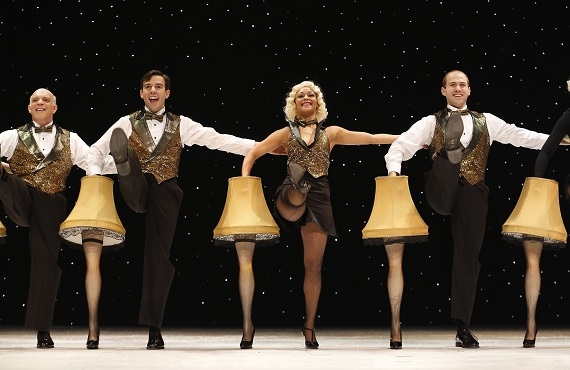
(© Carol Rosegg)







